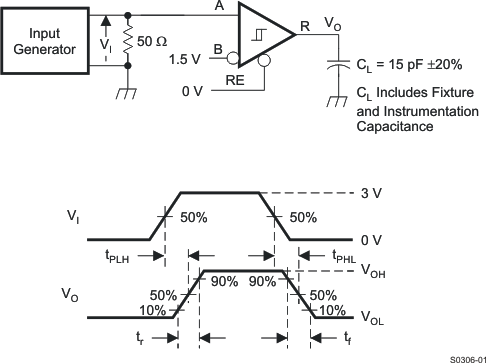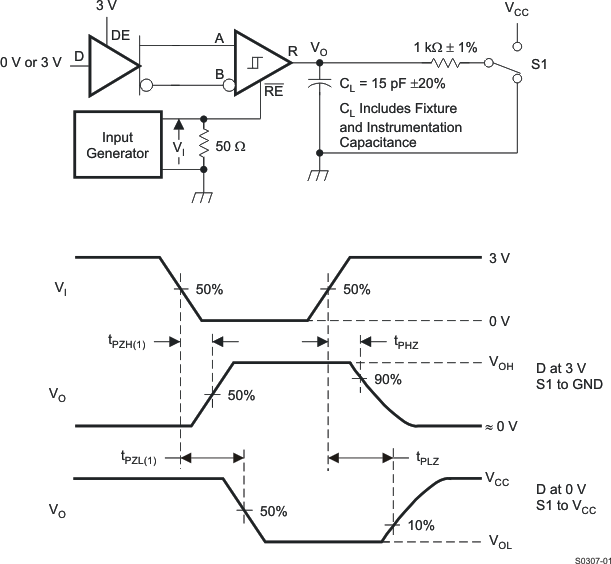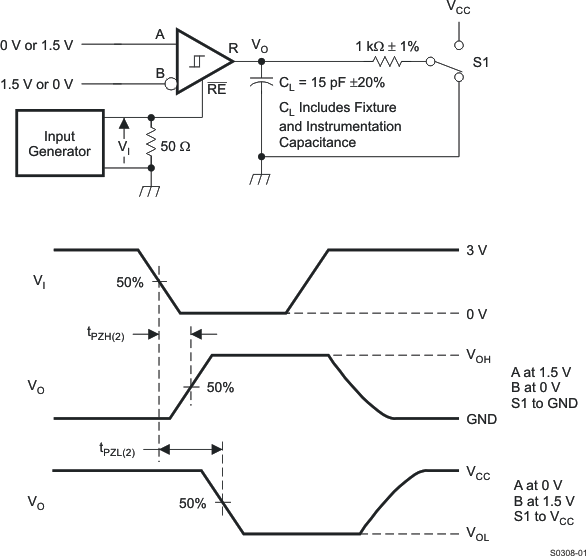SLLS872J January 2008 – March 2023 SN65HVD1785 , SN65HVD1786 , SN65HVD1787 , SN65HVD1791 , SN65HVD1792 , SN65HVD1793
PRODUCTION DATA
- 1 Features
- 2 Applications
- 3 Description
- 4 Revision History
- 5 Product Selection Guide
- 6 Pin Configuration and Functions
- 7 Specifications
- 8 Parameter Measurement Information
- 9 Detailed Description
- 10Application and Implementation
- 11Power Supply Recommendations
- 12Layout
- 13Device and Documentation Support
- 14Mechanical, Packaging, and Orderable Information
Package Options
Mechanical Data (Package|Pins)
- D|8
Thermal pad, mechanical data (Package|Pins)
- D|8
Orderable Information
8 Parameter Measurement Information
Input generator rate is 100 kbps, 50% duty cycle, rise and fall times less than 6 nsec, output impedance 50 Ω.
 Figure 8-1 Measurement of Driver Differential Output Voltage With Common-Mode Load
Figure 8-1 Measurement of Driver Differential Output Voltage With Common-Mode Load Figure 8-2 Measurement of Driver Differential and Common-Mode Output With RS-485 Load
Figure 8-2 Measurement of Driver Differential and Common-Mode Output With RS-485 Load Figure 8-3 Measurement of Driver Differential Output Rise and Fall Times and Propagation Delays
Figure 8-3 Measurement of Driver Differential Output Rise and Fall Times and Propagation Delays
D at 3 V to test non-inverting output, D at 0 V to test inverting output.
Figure 8-4 Measurement of Driver Enable and Disable Times With Active High Output and Pulldown Load
D at 0 V to test non-inverting output, D at 3 V to test inverting output.
Figure 8-5 Measurement of Driver Enable and Disable Times With Active-Low Output and Pullup Load Figure 8-6 Measurement of Receiver Output Rise and Fall Times and Propagation Delays
Figure 8-6 Measurement of Receiver Output Rise and Fall Times and Propagation Delays Figure 8-7 Measurement of Receiver Enable/Disable Times With Driver Enabled
Figure 8-7 Measurement of Receiver Enable/Disable Times With Driver Enabled Figure 8-8 Measurement of Receiver Enable Times With Driver Disabled
Figure 8-8 Measurement of Receiver Enable Times With Driver Disabled